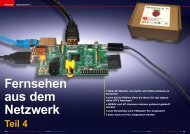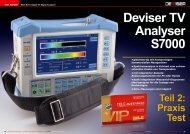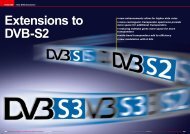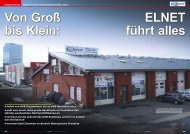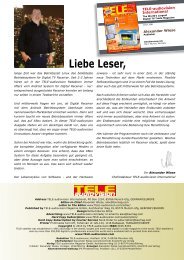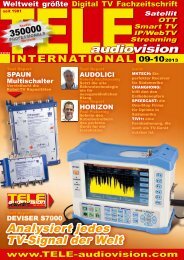deu TELE-audiovision 1311
Weltweit größte Digital TV Fachzeitschrift
Weltweit größte Digital TV Fachzeitschrift
Sie wollen auch ein ePaper? Erhöhen Sie die Reichweite Ihrer Titel.
YUMPU macht aus Druck-PDFs automatisch weboptimierte ePaper, die Google liebt.
55<br />
56<br />
57<br />
Ka-Band Satellite Scan<br />
56. This waterfall diagram shows the horizon from about 30.0E to<br />
30.0W using the Inverto Ka LNB. Only 9.0E is broadcasting transponders<br />
in the 19.7 GHz – 20.2 GHz range.<br />
57. This picture shows 9.0E over a period of time (about 30 seconds).<br />
The second half (lower part – representing about 15 seconds) of the<br />
waterfall diagram was recorded during a sporadic rain shower. Curiously<br />
the rain did not produce any signal loss.<br />
How to interpret BER<br />
measurements<br />
What does 1.2E-03<br />
mean? BER stands for Bit<br />
Error Ratio: the measuring<br />
instrument will basically<br />
count the erroneous<br />
bits within all received<br />
bits and calculate this<br />
simple formula:<br />
Because the amount<br />
of erroneous bits is normally<br />
very small, let’s<br />
say 1 wrong bit in every<br />
1.000.000 bits, it would<br />
look odd to see a value<br />
of 0.000001 on the<br />
meter’s screen. A much<br />
more convenient format<br />
would be 1x10-6. Calculators<br />
will frequently<br />
show this number as 1E-<br />
6, instead, to save some<br />
screen space. So this is<br />
what a reading of CBER =<br />
1.2E-03 means: you will<br />
get one wrong bit in every<br />
1200 bits received.<br />
Let’s do the math:<br />
CBER means that no error<br />
correction has been<br />
applied to the signal, so<br />
let’s now see what LBER<br />
< 1.0E-8 means:<br />
It means that after applying<br />
the error correction,<br />
we only will receive<br />
one bad bit every hundred<br />
million received bits.<br />
We will have a great picture<br />
without any noticeable<br />
artifacts. However,<br />
because our initial CBER<br />
value is low, there is no<br />
bad weather reserve.<br />
If the signals gets only<br />
slightly worse, the error<br />
correction will not be<br />
able to correct the incoming<br />
stream and picture<br />
artifacts will be produced.<br />
The thumb rule is: the<br />
smaller the BER value<br />
before error correction,<br />
the better. Notice that<br />
smaller means a bigger<br />
number after the “E”, because<br />
there is a “-“ sign:<br />
-5 is smaller than -3! The<br />
smaller the number, the<br />
more bad weather reserve<br />
you will get. The BER<br />
value after the error correction<br />
will give you an<br />
idea, if artifacts will be<br />
noticeable on the screen<br />
with the current signal.<br />
www.<strong>TELE</strong>-<strong>audiovision</strong>.com — 11-12/2013 — <strong>TELE</strong>-<strong>audiovision</strong> International — 全 球 发 行 量 最 大 的 数 字 电 视 杂 志<br />
53





